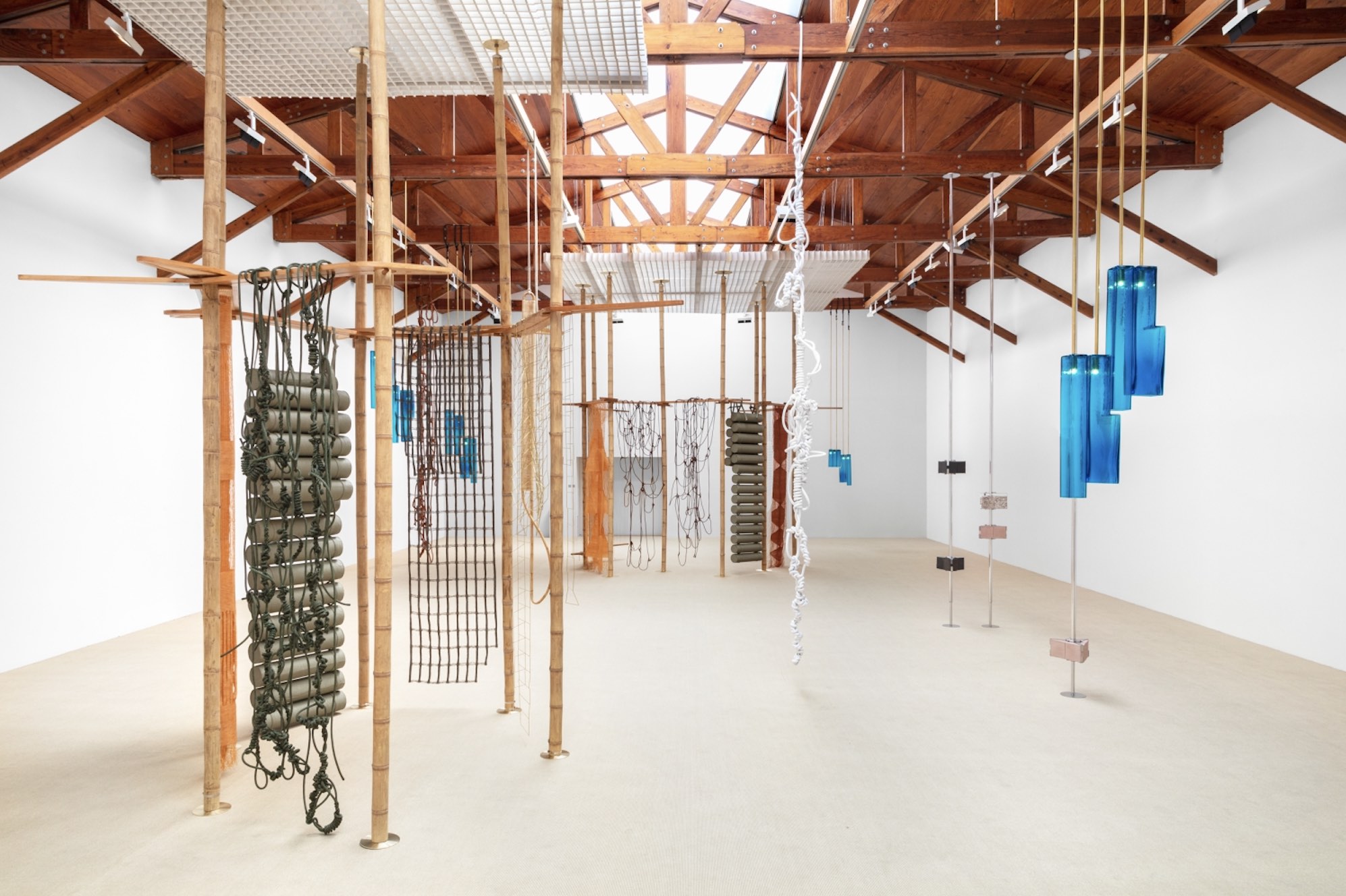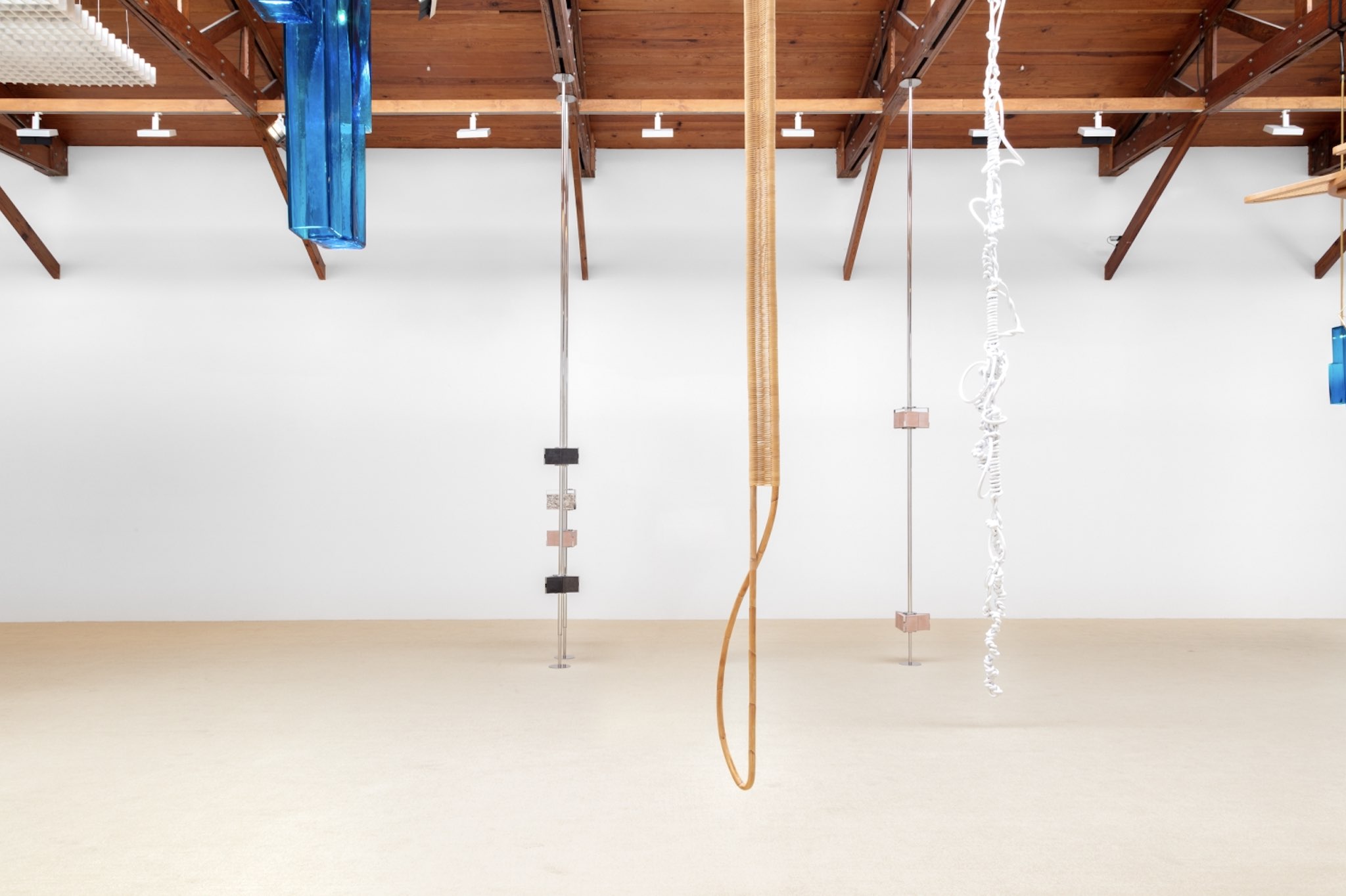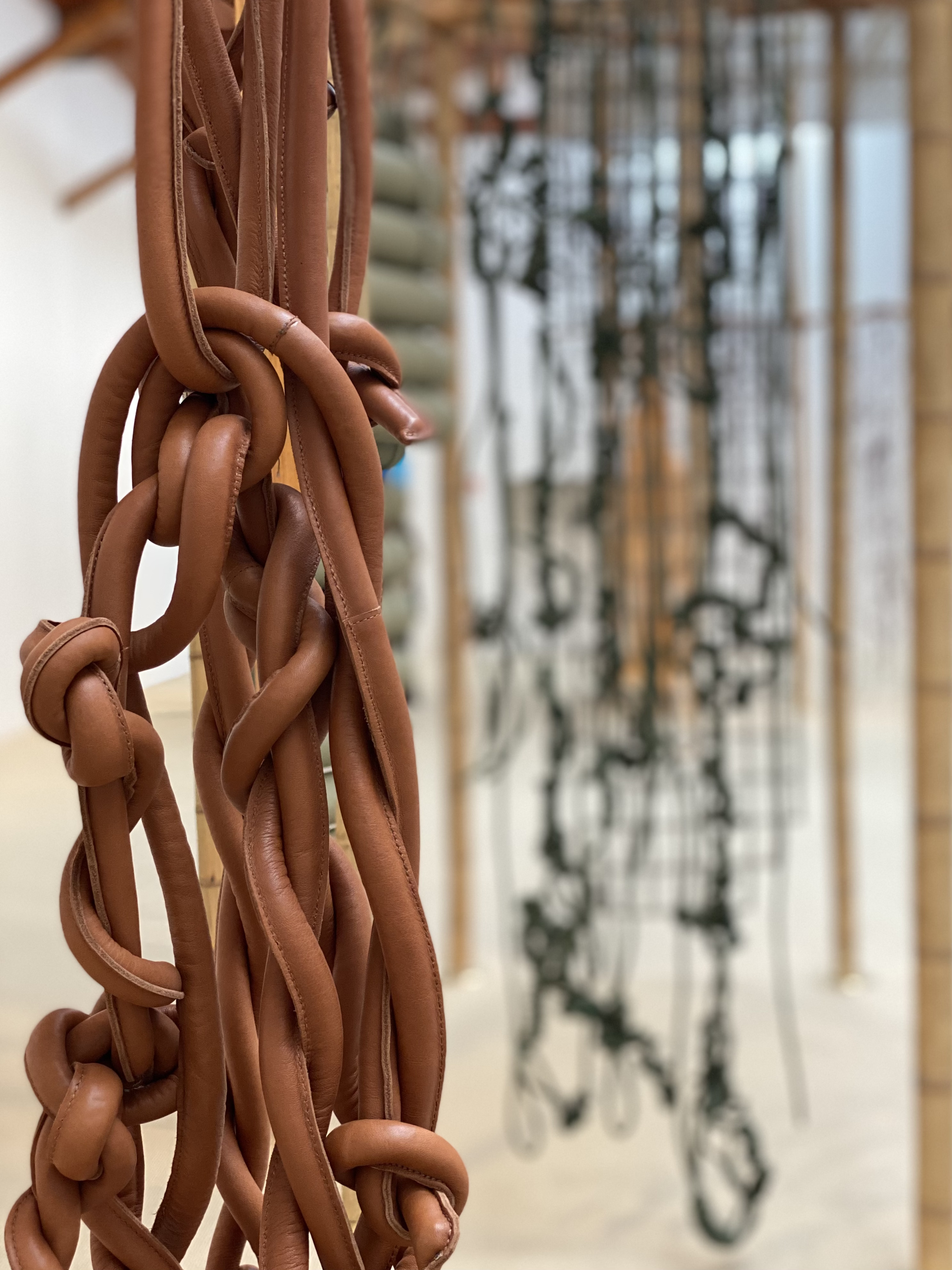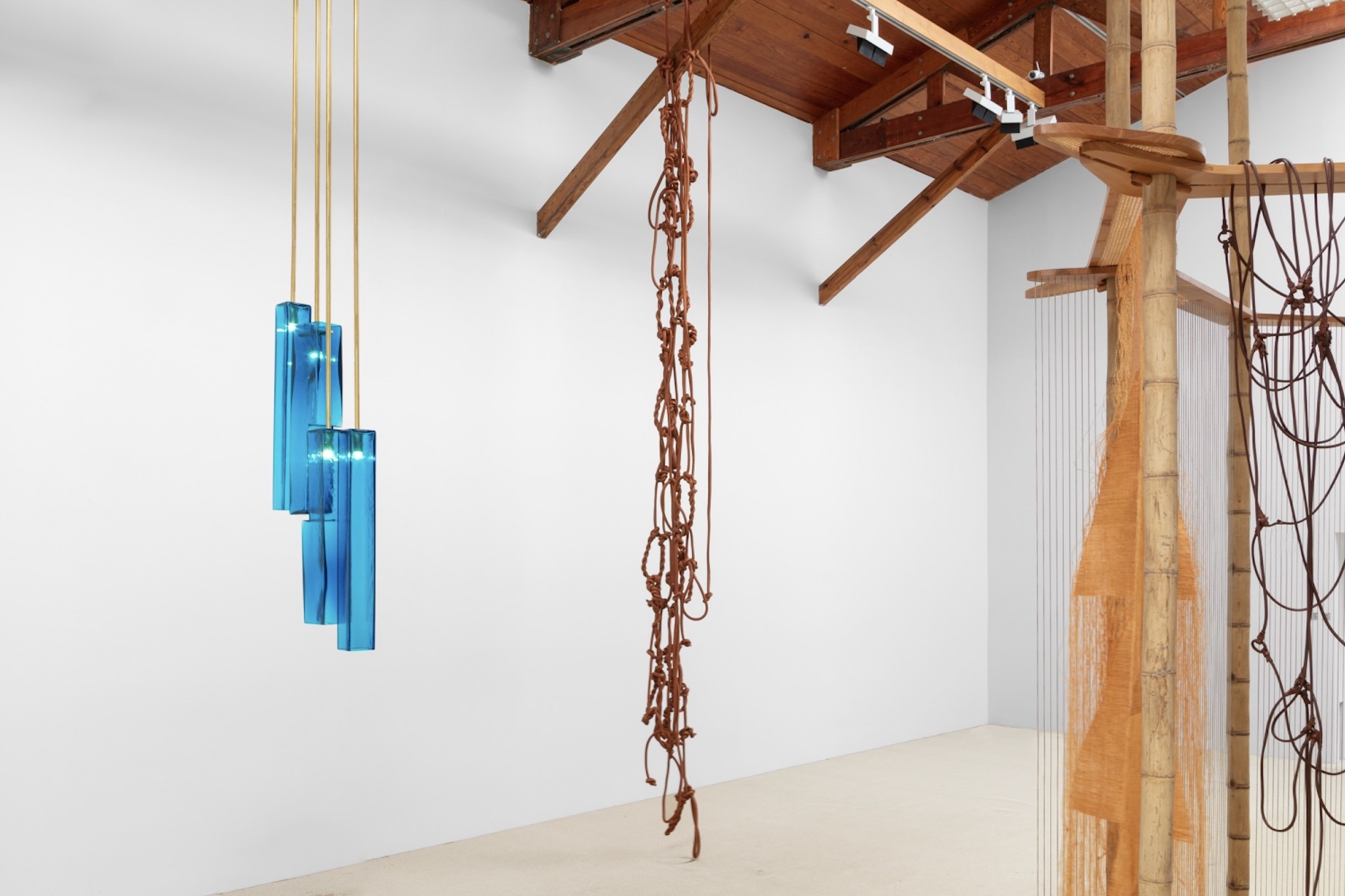
Review
Leonor Antunes: the homemaker and her domain, part III
by Isabel de la Vega
At kurimanzutto
Reading time
6 min
The gallery kurimanzutto presents The Homemaker and Her Domain, Part III by Leonor Antunes. Mainly interested in architecture, design, and sculpture, Antunes, an artist of Portuguese origin who investigates the work of little-known women artists of the 20th century, evokes in this exhibition the memory of the German architect Léna Meyer Bergner (1906–1981).*1
Atunes’s interest in this artist stems from the latter’s having make her work manifest during her stay in Mexico, where her visual production grew thanks to her collaborations with the Taller de la Gráfica Popular (“People’s Graphic Workshop”), without neglecting her textile and architectural work. In this space, she worked as a designer and editor, taking advantage of the possibility of imprinting her socialist ideals on her work and of continuing to position herself against communism. She also developed works that served as a channel of communication for illiterate persons, particularly regarding the social and political situation of the country.

In turn, the exhibition displays pieces inspired by the work of Clara Porset, Charlotte Perriand, Anni Albers, Trude Guermonprez, Eileen Gray, Lina Bo Bardi, Greta Grossman, Kay Sekimachi, Michiko Yamawaki, and Mira Schendel. Some of these women artists trained at the Bauhaus and later taught at Black Mountain College.
The reason for recovering these artists is not limited to inquiries about their contributions to the artistic field, but is rather a matter of revealing the support they provided in the training and formation of well-known personages—such as their own husbands, who used to sign their works when they could claim legitimizing titles in the profession.
The exhibition is based on the idea that the home is a feminine sphere: hence its title as well as the reason why Antunes chose women artists as a starting point. Through wooden structures that serve as a support for the pieces and that function as divisions among them, the museography responds to domestic spaces. Similarly, the living space is presented through chairs, lamps, shelves, and the carpet covering the hall, thus evoking environments familiar to the visitor.
The Homemaker and Her Domain, Part III presents works that were made recently and, in some cases, created expressly for the show, through which Antunes engages in dialogue with the work of those artists she investigates. An example of this is Discrepancies with M.Y. #1, 2021, made from a weaving by Japanese artist Michiko Yamawaki. Antunes considers her work an extension of the weaving, as each edge of the sculpture corresponds to a line in Yamawaki’s piece.
The homemaker and her domain II (the homemaker and her domain #2, discrepancies with M.Y. #1, chaise longue #2, discrepancies with T.G. #2 & #3, unpredictability of possible future uses), 2021, grew out of the artist’s residence in Los Angeles, for which she researched the work of the Swedish design and architect Greta Grossman, who built houses in that city. Antunes had the opportunity to visit these houses and to take measurements of various elements composing them, such as windows, protections, and door frames. Later, she used them to design lattices for her sculptures. Owing to the work’s material quality, rope and twists are applied to it. This work is abstract; however, if it were extended, it would be possible to identify what each weave corresponds to.

For its part, Discrepancies with M.S. #10, 2022, was born from the series Droguinhas (Little nothings), by the Brazilian artist Mira Schendel, who belonged to the Neo-Concrete Movement. Schendel created ephemeral pieces by folding rice paper. Antunes’s interpretation is focused on her ability to transform the foreground into a third dimension, which she resolves through knots created with cotton rope covered in leather, resulting in sculptures and furniture.
The ceramic pieces were created in a studio, based in Lisbon, where Antunes learned the technique and production of textures that can be made from the use of pastes. This allowed her to model Indirect lighting, group 3, 2021, which picks up on the lamps that the artist Charlotte Perriand created following her trip to Japan.
At kurimanzutto there are also the lamps that the artist showed in the pavilion of the 2019 Venice Biennale, where she represented Portugal, her country of origin. Antunes researched the artisan community that once characterized Venice, thus recovering Murano glass for Egle #19, 2019 and Egle #20, 2019. These pieces were based on the volumes of a building designed by Egle Renata Trincanato, one of the first Venetian architects.

Behind each piece there lies a story, one that is kept in the archive of measurements that Leonor Antunes feeds into her architectural explorations, and for which she makes use of her bodily scale.
Although it is true that Leonor Antunes must commission her work, the relationship she maintains with artisans shows her interest both in crafts and in the socialization and transmission of knowledge. This resonates with Léna Bergner’s interest in working toward and promoting the good of the community, something made evident through those of her projects that involved the “garden city.”*2
The interest in manual practices and productions is a constant that characterizes Antunes’s work as well as that of Léna Bergner. This thread has served to generate this exhibition, by using such materials as rope, wood, straw (silk), steel, ceramics, and leather. This manual work, something commonly related to the female gender, is a point that Antunes addresses in her production, seeking to eliminate the social character to which it has been linked, regarding it rather as a human work. In the same way, the study she makes of artists is a way of bestowing on them that recognition of creative power they did not enjoy in their times. Incurring this theme shows once again the interest that the artist has in ways of transmitting knowledge, which she exhibits via her work.
the homemaker and her domain, part III will be open until March 19, 2022.
— Isabel de la Vega
Taducido al inglés por Byron Davies
*1: Trained in the Bauhaus embroidery workshop, an area to which women were relegated because of their gender, Meyer Bergner managed to make her architectural work viable by designing weavings with isometric projections containing buildings, roads, and even subway lines.
*2: These are housing complexes arising from a vision of the family as the most important nucleus in the formation of the individual. They offer everything from houses with different numbers of rooms, depending on the number of children, to recreation areas for infants, spaces for social gatherings, and community gardens. Theses sites aim for cooperation and encounters among the community, as well as for dialogue and interaction among inhabitants.
Published on February 24 2022